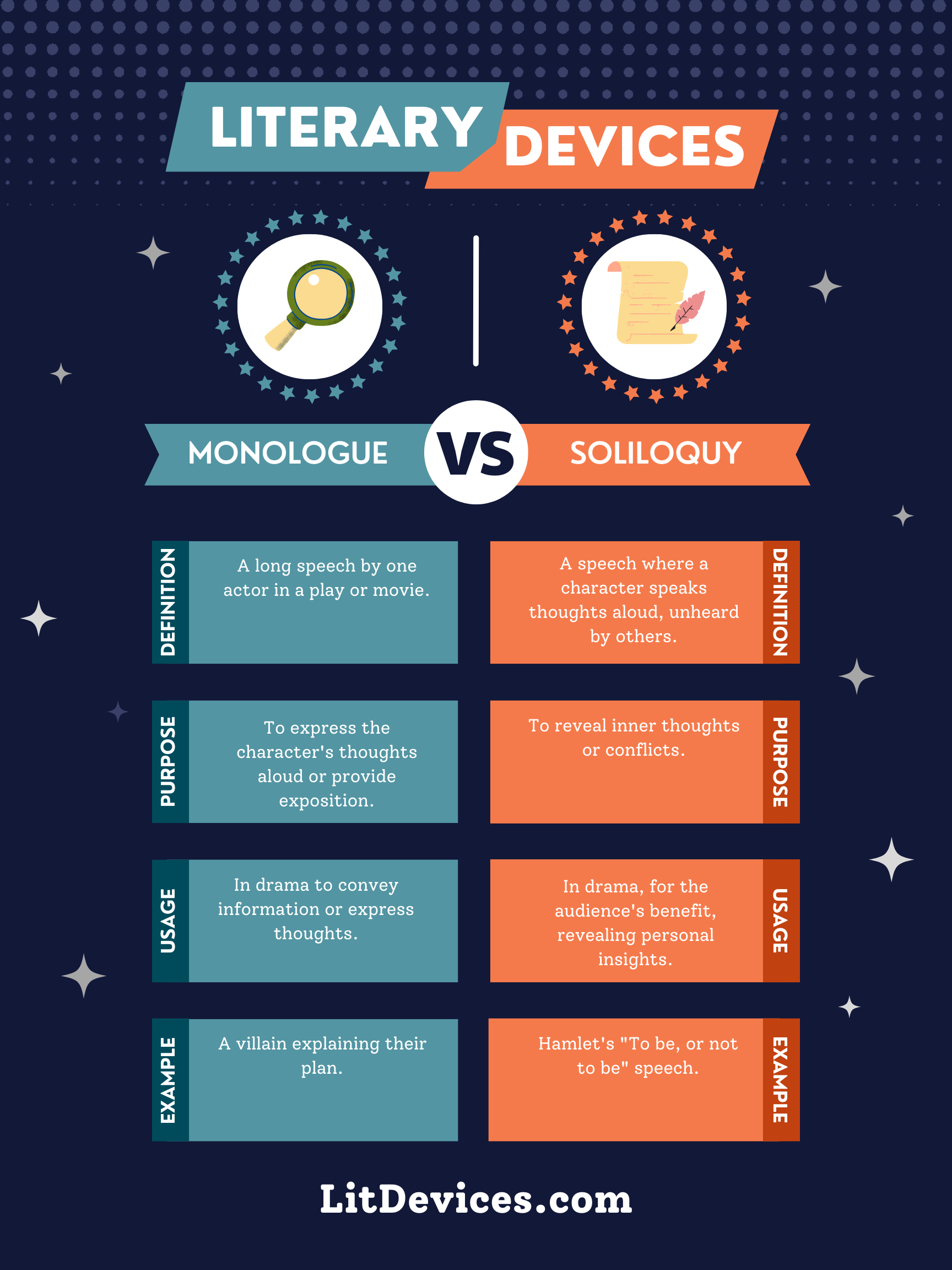Monologue is a long speech by one character to others; Soliloquy is a speech where a character speaks to themselves, revealing thoughts.
Monologue
A monologue is a lengthy speech delivered by a character to other characters within the scene. It’s used to express the speaker’s thoughts aloud or to directly address another character or the audience.
🗣 Example: Marc Antony’s speech in Shakespeare’s “Julius Caesar” (“Friends, Romans, countrymen, lend me your ears…”) is a monologue where Antony addresses the crowd, swaying public opinion.
Soliloquy
A soliloquy is a type of monologue where a character speaks to themselves, sharing their inner thoughts with the audience, usually without any other character hearing them. This device allows deeper insight into a character’s psyche.
💭 Example: Hamlet’s “To be, or not to be” speech in Shakespeare’s “Hamlet” is a soliloquy. It reveals Hamlet’s contemplation on existence and his internal struggle.
Summary
| Literary Device | Definition | Purpose | Usage | Relevant Examples |
|---|---|---|---|---|
| Monologue | A long speech by one character to other characters. | To express thoughts aloud, persuade, or inform others within the scene. | Used in plays, films, and literature where one character needs to convey significant information or emotion. | Marc Antony in “Julius Caesar.” |
| Soliloquy | A speech where a character speaks their thoughts aloud to themselves, unheard by other characters. | To reveal a character’s inner thoughts, feelings, and conflicts to the audience. | Primarily found in drama, particularly in Shakespearean works, to deepen character understanding. | Hamlet in “Hamlet.” |
Writing Tips
When writing a monologue or soliloquy:
- For Monologue: Focus on your character’s intention and whom they are addressing. The monologue should have a clear purpose, such as persuasion or revelation of key plot points, and should reflect the character’s personality and objectives.
- For Soliloquy: Use this device to explore your character’s internal dilemmas, desires, or decisions. It’s a chance to let the audience in on secrets or hidden emotions that other characters in the play or story are not privy to.
🖋 Example for Monologue: Imagine a scene where a character is confessing their life story or a secret plan to someone they trust (or to the audience), revealing motives, fears, or ambitions.
🖋 Example for Soliloquy: Craft a moment of introspection where your character debates a moral choice, revealing their values and the complexities of their decision-making process to the audience.
FAQs
Can a soliloquy be considered a monologue?
Yes, a soliloquy is a specific type of monologue, characterized by the speaker being alone, or speaking as if alone, revealing inner thoughts.
Is audience presence necessary for a monologue or soliloquy?
For a monologue, other characters are usually present. In a soliloquy, the character is often alone on stage, but the presence of an audience is essential for the device to fulfill its purpose of revealing inner thoughts.
How do I decide when to use a monologue vs. a soliloquy?
Use a monologue when you need a character to express thoughts, feelings, or information to other characters or the audience. Use a soliloquy to provide the audience with insight into a character’s private thoughts or dilemmas.
Exercise
Determine whether the following scenarios are examples of a monologue or a soliloquy:
- A character alone on stage muses about the nature of love and whether it’s worth the pain it often brings.
- In a crowded room, a character delivers a detailed account of their journey to a new land, addressing both the characters around them and the audience.
- A villain outlines their scheme to an empty room, detailing how they will defeat the hero.
- A teacher explains to their class the importance of being honest, weaving personal anecdotes into the lesson.
Answers:
Interesting Literary Device Comparisons
- Dialogue vs. Monologue: Dialogue involves a conversation between two or more characters, whereas a monologue is a speech given by a single character to other characters or the audience.
- Aside vs. Soliloquy: An aside is a brief remark by a character to the audience, often unnoticed by other characters, used to reveal private thoughts or judgments, whereas a soliloquy is a longer speech revealing a character’s inner thoughts.
- Narration vs. Monologue: Narration is the act of telling a story, often by a narrator, and can involve describing events, thoughts, and settings. A monologue, while it can narrate, is specifically a speech by a character within the story context.

